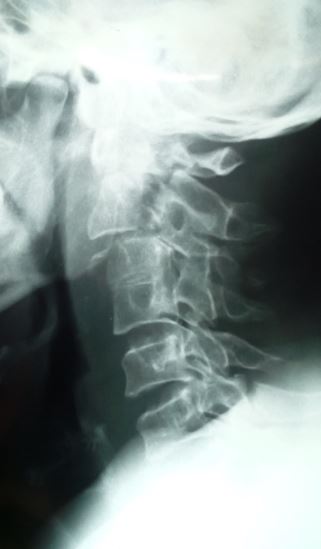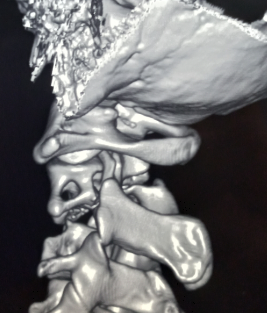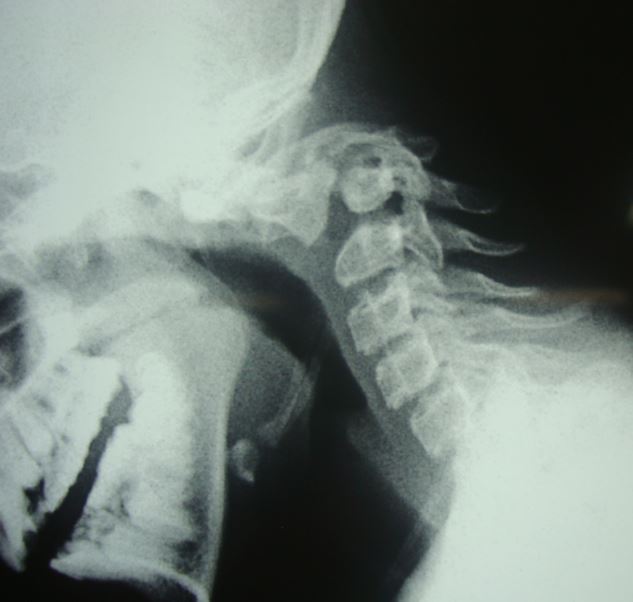[1]
Mudumba VS,Pavan S,Alugolu R, Saradhi's single stage, anterior sequential reduction utilizing C3 for type III hangman's fracture: A novel technique. Journal of craniovertebral junction & spine. 2022 Jan-Mar
[PubMed PMID: 35386244]
[2]
Cai Y,Khanpara S,Timaran D,Spence S,McCarty J,Aein A,Nunez L,Arevalo O,Riascos R, Traumatic spondylolisthesis of axis: clinical and imaging experience at a level one trauma center. Emergency radiology. 2022 Aug
[PubMed PMID: 35543854]
[3]
Menon VK, Mechanically Relevant Anatomy of the Axis Vertebra and Its Relation to Hangman's Fracture: An Illustrated Essay. Neurospine. 2019 Jun
[PubMed PMID: 31261461]
[4]
Turtle J,Kantor A,Spina NT,France JC,Lawrence BD, Hangman's Fracture. Clinical spine surgery. 2020 Nov
[PubMed PMID: 33044269]
[5]
Spence KF Jr,Decker S,Sell KW, Bursting atlantal fracture associated with rupture of the transverse ligament. The Journal of bone and joint surgery. American volume. 1970 Apr
[PubMed PMID: 5425648]
[7]
Robinson AL,Olerud C,Robinson Y, Epidemiology of C2 Fractures in the 21st Century: A National Registry Cohort Study of 6,370 Patients from 1997 to 2014. Advances in orthopedics. 2017
[PubMed PMID: 29181200]
Level 3 (low-level) evidence
[8]
Levine AM,Edwards CC, The management of traumatic spondylolisthesis of the axis. The Journal of bone and joint surgery. American volume. 1985 Feb
[PubMed PMID: 3968113]
[9]
Francis WR,Fielding JW,Hawkins RJ,Pepin J,Hensinger R, Traumatic spondylolisthesis of the axis. The Journal of bone and joint surgery. British volume. 1981
[PubMed PMID: 7263740]
[10]
Scholz M,Kandziora F,Kobbe P,Matschke S,Schleicher P,Josten C,Spine Section of the German Society for Orthopaedics and Trauma, Treatment of Axis Ring Fractures: Recommendations of the Spine Section of the German Society for Orthopaedics and Trauma (DGOU). Global spine journal. 2018 Sep
[PubMed PMID: 30210957]
[11]
Pinter ZW,Lawson BK,Freedman BA,Sebastian AS, Atypical hangman's fracture with concomitant subaxial fracture-dislocation treated with circumferential fusion of C2-C5-a case report. Spinal cord series and cases. 2020 Dec 2
[PubMed PMID: 33268764]
Level 3 (low-level) evidence
[12]
Prasad GL, Traumatic irreducible non-Hangman's type bilateral C2-C3 high-grade facet dislocation: technical nuance. British journal of neurosurgery. 2020 Dec 2
[PubMed PMID: 33263442]
[13]
Jain S,Mishra K,Gandhi A,Garg D, Curious Case of Atypical Hangman's Fracture: C2-C3 Listhesis without Pars Fracture. Journal of neurosciences in rural practice. 2020 Oct
[PubMed PMID: 33144811]
Level 3 (low-level) evidence
[14]
Aljuboori Z,Hoz S,Boakye M, Failure of C2-3 anterior arthrodesis for the treatment of atypical Hangman's fractures: A three case series. Surgical neurology international. 2020
[PubMed PMID: 32257578]
Level 2 (mid-level) evidence
[15]
Kim SK,Rhee JM,Park ET,Seo HY, Surgical Outcomes for C(2) Tear Drop Fractures: Clinical Relevance to Hangman's Fracture and C(2-3) Discoligamentous Injury. Orthopaedic surgery. 2021 Dec
[PubMed PMID: 34791834]
[16]
Gupta P,Kumar A,Gamangatti S, Mechanism and patterns of cervical spine fractures-dislocations in vertebral artery injury. Journal of craniovertebral junction
[PubMed PMID: 23741123]
[17]
Pratt H,Davies E,King L, Traumatic injuries of the c1/c2 complex: computed tomographic imaging appearances. Current problems in diagnostic radiology. 2008 Jan-Feb
[PubMed PMID: 18054664]
[18]
Tuite GF,Papadopoulos SM,Sonntag VK, Caspar plate fixation for the treatment of complex hangman's fractures. Neurosurgery. 1992 May
[PubMed PMID: 1584391]
[19]
Coric D,Wilson JA,Kelly DL Jr, Treatment of traumatic spondylolisthesis of the axis with nonrigid immobilization: a review of 64 cases. Journal of neurosurgery. 1996 Oct
[PubMed PMID: 8814154]
Level 3 (low-level) evidence
[21]
Prost S,Barrey C,Blondel B,Fuentes S,Barresi L,Nicot B,Challier V,Lleu M,Godard J,Kouyoumdjian P,Lonjon N,Marinho P,Freitas E,Schuller S,Allia J,Berthiller J,Charles YP,French Society for Spine Surgery (SFCR), Hangman's fracture: Management strategy and healing rate in a prospective multi-centre observational study of 34 patients. Orthopaedics & traumatology, surgery & research : OTSR. 2019 Jun
[PubMed PMID: 31005699]
Level 2 (mid-level) evidence
[22]
Kurucan E,Sulovari A,Thirukumaran C,Greenstein A,Molinari R,Mesfin A, Volume-outcome relationship in halo vest utilization for C2 fractures. The spine journal : official journal of the North American Spine Society. 2020 Oct;
[PubMed PMID: 32474222]
[23]
Isidro S,Molinari R,Ikpeze T,Hernandez C,Mahmoudi MS,Mesfin A, Outcomes of Halo Immobilization for Cervical Spine Fractures. Global spine journal. 2019 Aug
[PubMed PMID: 31431875]
[24]
Verma S,Singh PK,Agrawal M,Sawarkar D,Borkar SA,Kumar A,Garg K,Agrawal D,Gupta D,Satyarthee G,Chandra SP,Kale SS, Use of Intraoperative Imaging to Preserve C1-C2 Mobility in Complex Atlas-Hangman Fractures. Neurology India. 2022 Jan-Feb
[PubMed PMID: 35263885]
[25]
Menger RP,Storey CM,Nixon MK,Haydel J,Nanda A,Sin A, Placement of C1 Pedicle Screws Using Minimal Exposure: Radiographic, Clinical, and Literature Validation. International journal of spine surgery. 2015
[PubMed PMID: 26484006]
Level 1 (high-level) evidence
[26]
Patel JYK,Kundnani VG,Kuriya S,Raut S,Meena M, Unstable Hangman's fracture: Anterior or posterior surgery? Journal of craniovertebral junction & spine. 2019 Oct-Dec
[PubMed PMID: 32089613]
[27]
Jun XH,Yi L, Percutaneous Fixation of Levine-Edwards Type II Hangman's Fractures Under the Guidance of an Orthopedic Robot. Orthopedics. 2023 Jan-Feb
[PubMed PMID: 36343643]
[28]
Sacino AN,Materi J,Davidar AD,Judy B,Liu A,Hwang B,Theodore N, Robot-assisted atlantoaxial fixation: illustrative cases. Journal of neurosurgery. Case lessons. 2022 Jun 20
[PubMed PMID: 35733845]
Level 3 (low-level) evidence
[29]
Asuzu DT,Buchholz AL, MAZOR-X robotic-navigated percutaneous C2 screw placement for hangman's fracture: a case report. Journal of spine surgery (Hong Kong). 2021 Sep
[PubMed PMID: 34734148]
Level 3 (low-level) evidence
[30]
Daves GD Jr, The occurrence of natural stable analogues. Implications for the design of therapeutic agents. Acta pharmaceutica Suecica. 1987
[PubMed PMID: 3330895]
[31]
Oswald KAC,Deml MC,Heldner MR,Seiffge D,Bigdon SF,Albers CE, Intraoperative color-coded duplex ultrasound for safe surgical reduction of displaced hangman fractures in patients with atypical course of the vertebral artery: A case report of two patients. Trauma case reports. 2022 Feb
[PubMed PMID: 34917739]
Level 3 (low-level) evidence
[32]
Xu D,Gan K,Wang Y,Wang Y,Ma W, Comparison of C2-3 Pedicle Screw Fixation With C2 Spinous Muscle Complex and Iliac Bone Graft for Instable Hangman Fracture. Frontiers in surgery. 2021
[PubMed PMID: 34901137]
[33]
Ashraf AM,Houten JK, A Potentially Advantageous Use of a Zero-Profile, Stand-Alone Anterior Interbody Spacer at C2-3 for the Treatment of Hangman's Fracture: A Technical Case Report. Cureus. 2021 Jun
[PubMed PMID: 34354875]
Level 3 (low-level) evidence
[34]
Basankin IV,Giulzatyan АА,Nesterenko PB,Bagaudinov АB,Tayurski DА,Mukhanov МL, Experience of Using Transpedicular Osteosynthesis in Traumatic Spondylolisthesis of the Axis. Sovremennye tekhnologii v meditsine. 2021
[PubMed PMID: 35265349]
[35]
Liu Y,Zhu Y,Li X,Chen J,Yang S,Yang H,Jiang W, A new transpedicular lag screw fixation for treatment of unstable Hangman's fracture: a minimum 2-year follow-up study. Journal of orthopaedic surgery and research. 2020 Sep 1
[PubMed PMID: 32873313]
[36]
Agrawal M,Sawarkar D,Singh PK,Mishra S,Meena R,Gupta DK,Chandra PS,Kale SS, Posterior fixation for paediatric and adolescent unstable hangman's fracture: evolution to C1 sparing techniques. Child's nervous system : ChNS : official journal of the International Society for Pediatric Neurosurgery. 2021 Jul
[PubMed PMID: 33783618]
[37]
Sawarkar D,Agrawal M,Singh PK,Mishra S,Agrawal D,Kumar A,Verma S,Doddamani R,Meena R,Garg K,Gurjar H,Chandra PS,Kale SS, Evolution to Pedicle Reformation Technique in Surgical Management of Hangman's Fracture. World neurosurgery. 2021 May
[PubMed PMID: 33567364]
[38]
Jin C,Xie N,Ren Y,Liu X,Tang F,Guo Q,Jia L,Cheng L, How Does Cervical Sagittal Balance Change After Hangman Fracture Treated with Anterior or Posterior Approach Surgery? World neurosurgery. 2020 Jun
[PubMed PMID: 32201290]
[39]
Man Kyu C,Youngseok K,Ki Hong K,Dae-Hyun K, Direct trans-pedicular screw fixation for atypical hangman's fracture: A minimally invasive technique using the tubular retractor system. Journal of clinical neuroscience : official journal of the Neurosurgical Society of Australasia. 2019 Dec
[PubMed PMID: 31431401]
[40]
Soliman MAR,Kwan BYM,Jhawar BS, Minimally Invasive Unilateral Percutaneous Transfracture Fixation of a Hangman's Fracture Using Neuronavigation and Intraoperative Fluoroscopy. World neurosurgery. 2019 Feb
[PubMed PMID: 30391610]
[41]
Yuan S,Wei B,Tian Y,Yan J,Xu W,Wang L,Liu X, Posterior temporary C1-2 fixation for 3-part fractures of the axis (odontoid dens and Hangman fractures). Medicine. 2018 Nov;
[PubMed PMID: 30508884]
[42]
Ryken TC, Hadley MN, Aarabi B, Dhall SS, Gelb DE, Hurlbert RJ, Rozzelle CJ, Theodore N, Walters BC. Management of isolated fractures of the axis in adults. Neurosurgery. 2013 Mar:72 Suppl 2():132-50. doi: 10.1227/NEU.0b013e318276ee40. Epub
[PubMed PMID: 23417186]
[43]
Karakoyun DO,Yılmaz A,Uzlu O,Dağlıoğlu E,Işık HS, Vertebral arteriovenous fistula due to blunt neck trauma: A case report. Ulusal travma ve acil cerrahi dergisi = Turkish journal of trauma & emergency surgery : TJTES. 2022 Jun
[PubMed PMID: 35652878]
Level 3 (low-level) evidence
[44]
Sarath Chander V,Govindasamy R,Rudrappa S,Gopal S, Unstable Hangman Fracture Complicated by Vertebral-Venous Fistula: Surgical Considerations and Review of Literature. World neurosurgery. 2021 Jan
[PubMed PMID: 32987171]
[45]
Kaiser R,Saur K,Smolanka A,Ullas G,Beneš V, Type-III Hangman's fracture combined with serious cerebrovascular injury after near-hanging: a first case report and review of the literature. British journal of neurosurgery. 2019 Sep 28
[PubMed PMID: 31566025]
Level 3 (low-level) evidence
[46]
Láinez Ramos-Bossini AJ,Gálvez López R,Pastor Rull J, Vertebral artery dissection secondary to hangman's fracture. Medicina clinica. 2020 Mar 13
[PubMed PMID: 30954291]
[47]
Foster MA,Gridley DG,Lettieri SC,Feiz-Erfan I, Brown-Sequard syndrome associated with hangman fracture after blunt trauma: A case report. Surgical neurology international. 2022
[PubMed PMID: 35509566]
Level 3 (low-level) evidence
[48]
Yang Y,Dai L,Ma L,Gao X,Liu H, Incidence of dysphagia and dysphonia after Hangman's fractures: Evidence from 93 patients. Medicine. 2018 Dec
[PubMed PMID: 30544470]
[49]
Pehler S,Jones R,Staggers JR,Antonetti J,McGwin G,Theiss SM, Clinical Outcomes of Cervical Facet Fractures Treated Nonoperatively With Hard Collar or Halo Immobilization. Global spine journal. 2019 Feb;
[PubMed PMID: 30775208]
Level 2 (mid-level) evidence



